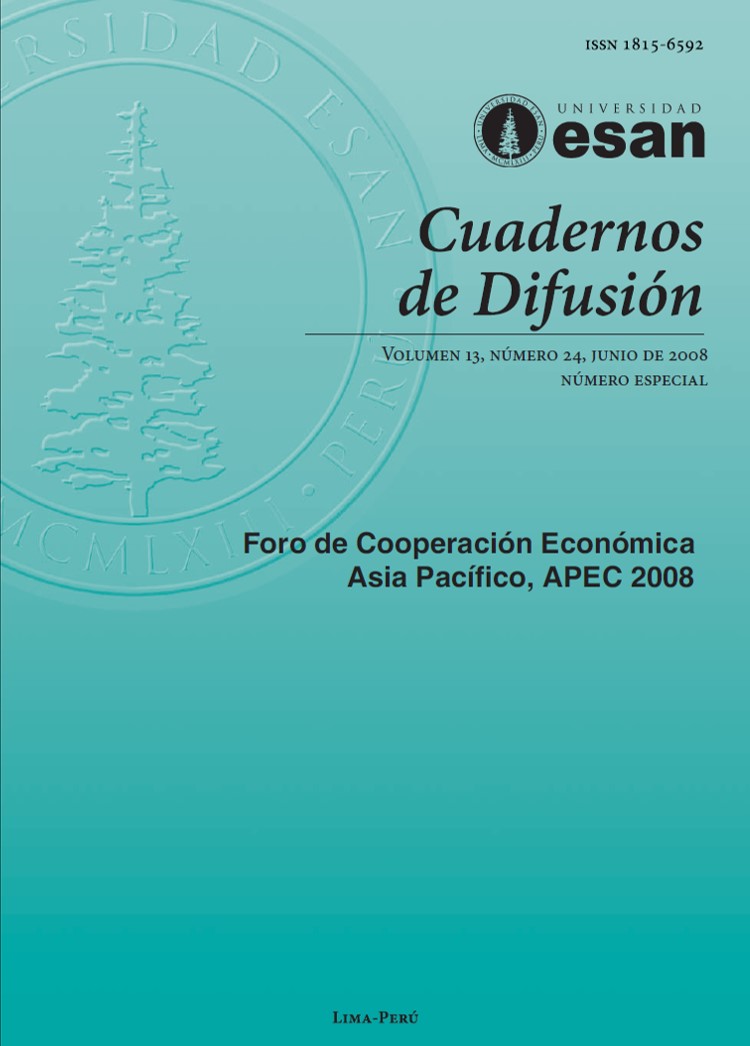International law and the role of APEC in the gobernance of economic coorperation within the Asia Pacific region
DOI:
https://doi.org/10.46631/jefas.2008.v13n24.03Keywords:
APEC, WTO, legal framework, governance, economic cooperation, soft law, hard lawAbstract
The cumbersome administrative process of trading in the Asia Pacifi c region has lead to propose the creation of a Free Trade Area of the Asia Pacifi c Region (FTAAP), as part of the governance structure. In this respect, the Asia Pacifi c Economic Cooperation (APEC) would play a major role regarding the setting of guidelines for economic cooperation and a free and open approach to investments. It is also provided that APEC’s legal framework may be applied to the economic activities which have not been regulated by other international agreements, offering advantages as adapting to the real conditions of each state and the standardization of the already existing regulations. However, this non-binding framework, (soft law), does not foreclose, but complements the OMC’s binding legal framework (hard law).
Downloads
References
ASIA PACIFIC ECONOMIC COOPERATION (APEC). 2005. Busan Roadmap to Bogor Goals. Document 2005/AMM/002anx1rev1. Agenda Item: IV, V, p. 13. 17th APEC Ministerial Meeting Busan, Korea, Nov. 15-16.
BAYNE, Sir Nicholas. 2004. Hard and Soft Law in International Institutions: Complements, Not Alternatives. In Kirton, John J., and Trebilcock, Michael J. (eds.) Hard Choices, Soft Law Voluntary Standards in Global
Trade, Environment and Social Governance. Aldershot and Burlington: Ash Gate.
CHO, Sungjoon. 2007. Is a Free Trade Agreement a Royal Road To Prosperity? Demystifying Trade Regionalism. Static and Dynamic Consequences of a KORUS FTA. May, 1. Vol. 4 in KEI Special Studies Series, published by Korea Economic Institute of America. <http://keia.org/2-Publications/2-4-Adhoc/FTAConferenceVolume2007/FTAConferenceVolume-Contents07.html>, (accessed Nov. 16, 2007).
CRAIK, A. Neil. 1998. Recalcitrant Reality and Chosen Ideals: The Public Function Of Dispute Settlement In International Environmental Law. Geo. Int’l Envtl. L. Rev. Vol. 10.
D’AMATO, Anthony. 1987. Is International Law Really ‘Law’?, chapter 1. In D’Amato, Anthony. International Law: Process and Prospect, pp.1-26. Dobbs Ferry: National Publishers Inc.
DAVIDSON, Paul J. 2002. Rules-Based?- APEC’s Role in the Evolving International Legal Framework for Regulating International Economic Relations, paper presented at the APEC Study Centre 2002 Conference, Merida, Mexico. May 22-24.
DIXIT, Avinash. 2002. Lawlessness and Economics: Alternative Modes of Economic Governance. Dec., 11. Gorman Lectures. London: University College. <http://www.econ.ucl.ac.uk/downloads/Lec1.pdf> (accessed Aug. 6, 2007).
ELEK, Andrew. 2007. The Asia Pacifi c Region: economic integration in the 21st century. Paper prepared for APEC 2007 SOM 2, APEC Trade Policy Dialogue - Strengthening Regional Economic Integration, Adelaide, Australia, Apr. 22, 2007/SOM2/
TPD/002.
EMPLOYMENT AND TRAINING ADMINISTRATION (ETA). 2001. Trade Act Participant Report (TAPR), Document II.B.3.a. U.S. Department of Labor. Washington, D. C.
.2002. Trade Act Participant Report (TAPR), Document III.A.A1. U.S. Department of Labor. Washington, D. C. GOLD, Joseph. 1983. Strengthening the Soft
International Law of Exchange Agreements. The American Journal of International Law. N.º 77.
HILLGENBERG, Harmut. 1999. A Fresh Look at Soft Law. Economic Journal of International Law. Vol. 10.
JOHNSTON, Douglas M. 2001. Commitment and Compliance: The Role of Non-Binding
Norms in the International Legal System. The American Journal of International Law. N.º 95.
KOH, H.H. 1997. Why Do Nations Obey International Law? Review Essay. The Yale Law Journal. N.º 106.
LLOYD, P. J. 2002. Implications for the Multilateral Trading System of the New Preferential Trading Arrangements in the Asia-Pacific Region.
PECC Seminar on Developing Patterns of Regional Trading Arrangements in the Asia-Pacifi c Region:
Issues and Implications. Vancouver, BC, Canada. Nov. 11-12. <http://www.pecc.org/publications/papers/trade-papers/1_SII/9-lloyd.pdf>.
LLOYD, Dennis. 1964. The Idea of Law. Harmondsworth: Penguin.
MENDOZA, M.R.; LOW, P. and KOTSCHWAR, B. (eds.) 1999. Trade rules in the making: challenges in regional and multilateral negotiations. Washington, D.C.: Organization of American States; Brookings Institution Press. (In ‘An Overview’ by editors).
SENDEN, Linda. 2005. Soft Law, Self Regulation and Co-regulation in European Law: Where Do They Meet? Electronic Journal of Comparative Law. Vol. 9.1. , referring to Article 11 EC and
Title VII of the EU Treaty.
SHELTON, Dinah. 2000. Law, Non-Law and the Problem of “Soft Law”. Introduction in Shelton, Dinah (ed.) Commitment and Compliance: The Role of Non-Binding Norms in the International Legal System. Oxford and New York: Oxford University Press.
PENG, Shin-Yi. 2000. The WTO Legalistic Approach and East Asia: From the Legal Culture Perspective. Asian-Pacific L. & Pol’y J. Vol. 1. N.º 13.
TUMBARELLO, Patrizia. 2007. ‘Noodle Bowl’ Risk of Trade Pact Overlap. IMF Survey Magazine. Jun., 25. <http://www.imf.org/external/pubs/ft/survey/so/2007/CAR0625A.htm#top> (last accessed, April 1, 2008).
WOODHEAD, Geoffrey. 2007. IAP Peer Reviews: APEC Member Economies Make Progress. APEC E-Newsletter. Mar. Vol. 12. The APEC Secretariat’s Finance Direction.
Downloads
Published
How to Cite
Issue
Section
License
Copyright (c) 2021 Journal of Economics, Finance and Administrative Science

This work is licensed under a Creative Commons Attribution 4.0 International License.











